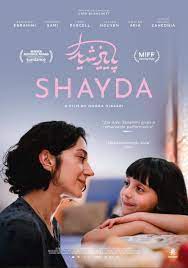
SHAYDA
Australia, 2023, 117 minutes, Colour.
Zar Amir Ebrahimi, Selina Zahednia, Leah Purcell, Osama Sami, Mojean Aria, Lucinda Armstrong Hall, Jillian Nguyen, Eve Morey, Rena Moser Harvey.
Directed by Noora Niasari.
On the day of the Australian release of Shayda, the Nobel Peace Prize was awarded to Narges Mohammadi, strong advocate for women’s rights in Iran, long imprisoned. Shayda is a story of Iranian women.
The writer-director of many short films, Noora Niasari, has made her first feature film, a memoir, dedicated to her mother (with some home video footage at the final credits. Iranian actress, Zar Amir Ibrahim he brings to sad and vivid life, Shayda, the wife of Hossein (Osama Sami), married in Iran, but he studying to be a doctor in Australia, bringing his wife and young daughter. However, he is arrogant in his treatment of his wife, brutal. She has fled with her daughter, a persuasive first performance by the young Selina Zahdenia.
Clearly, this is going to be a harrowing story. And it is.
While much of the dialogue is in English, Mona speaks Farsi and communicates with her mother in Farsi. Members of the Iranian community also speak in Farsi as does Shayda on the phone with her mother. There is a lot of atmosphere with the Iranian community, especially its traditions of its New Year, celebration, meals, gifts, and walking through fire with wishes and hopes.
The film is powerful because the writer-director is remembering her past, 1995, at the age of five, living in Brisbane. Shayda and Mona have fled the house, and are living in a women’s shelter, managed by a very sympathetic social worker, Joyce, played by veteran Leah Purcell. They live in a suburban house, generally two more women with their children, and a co-worker. The film immerses the audience in the day-to-day realities of living in the shelter, the emotional stress, interactions with the other women and children, managing to live, do some cooking, a little dancing, and Mona’s weekly outings with her father, meeting at an anonymous spot and returning there, Mona hoping to see The Lion King (her father gives her a little present of a toy Simba, the name she also gives to her goldfish).
The past narrative is offered to the audience via the device of having Shayda prepare a document for divorce proceedings, read in English by Joyce, then translated into Farsi. There are the young students in Tehran, 1984, the wedding, the birth of their child, coming to Australia, and flashback memories of a brutal attack by Hossein on his wife. At one stage, Mona asks her father, “a you going to hurt mummy again?”.
Hossein is also jealous, suspicious of his wife. A young visitor from Canada to stay with Shayda’s friends, encounters her in some moments of freedom, dressed up at a dance. He is friendly, poetic, attracted, intriguing Sayda. And he becomes the target of scenes physical brutality by Hossein.
While the focus is on Shayda and Mona, there are also some complications with some of the other women at the shelter – and, the tragedy of arson on the shelter and the consequences for the women and children.
Because this film is a tribute to her mother by the director, we know that ultimately there was a happy ending. But, it is a harrowing experience to share such unhappiness, such brutality, such threats, such uncertainty, moments of grief.
- The work of the writer-director, a memoir, her mother, her own experiences at a young age? The atmosphere of the 1990s in Australia? For Iranians, migrants?
- A film for women? Treatment by men, husbands? Brutality? Considered inferior? Women taking a stance? The importance of women’s shelters? For the women, for the children?
- Audience knowledge of Iran and its traditions, men and women, marriage, husbands and divorce? The control of women, clothing… In Iran?
- The portrait of Shayda? Her age, the information about she and Hossein as students, the marriage, their daughter, coming to Australia, his studies, to be a doctor, veterinary, Shayda and her attempts at study, the experience with her husband, leaving, with her daughter, the shelter? His threats, his returning to Iran, no divorce, wanting his daughter?
- Shayda and Mona, the relationship, at home, at the shelter, speaking in Farsi, Joyce and her support, the other woman and her seeming to ignore Shayda, the other mothers, Asian, British, the children? Cooking, drawing, the goldfish, dancing?
- Mona going out with her father, the anonymous meeting place, the bond between father and daughter, Hossein and his hostility towards his wife? The outings, the toy, Simba? Wanting to see The Lion King? The second outing, not going to the cinema, scenes spying on his wife, suspicious? Her asking him whether he was going to hurt mummy?
- The pressure on Shayda, the threat about Iran, losing custody, Joyce and her reading out the statement for divorce, the translation? Moods, with her daughter? The cheerful Asian mother, the dresses, going out, the party, the dancing? The encounter with the friend from Canada? Elly and Shayda’s friends?
- The background of the Iranian New Year, the feast, the fire, wishes, celebrations? Shayda, the encounter with the young man, poetic, urging her to breathe and let go of fears? Hossein, his arrival, brutality, the violence towards the young man? His arrest, imprisonment?
- The arson, the families having to leave, find alternate shelter, the injury to the supervisor? At the alternate shelter, moments of quiet?
- The visit to Hossein in prison, father and daughter?
- The story having a happy ending because of the experience of the mother and the daughter – and the glimpses, personal video the end of the film?
- The insights in the particular Iranian situation? But the universal issue of violence towards women, towards children, the law, shelters?